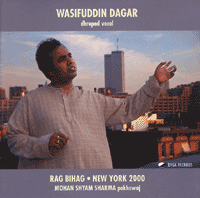
May 22, 2000
MUSIC REVIEW
By JON PARELES
Twenty generations of the Dagar family have sung dhrupad, the austerely devotional style of raga that Faiyaz Wasifuddin Dagar performed at the Washington Square Church on Wednesday. It was his United States debut.
His family's school of dhrupad performance, Dagarvani, has upheld a tradition that dates back at least 500 years in India. It is a style that demands virtuosity, with attention to microtonal nuances of pitch and to precise shadings of tone, but it is not showy. Performances are extended prayers: meditations that move, after great deliberation, into rhythmic chants of the Sama Veda.
In his three-hour concert, Mr. Dagar sang two ragas. Each began with Mr. Dagar's voice hovering within the slowly undulating drone of two tanpuras (long-necked lutes), humming or intoning "Om." His tone was quiet, almost disembodied, wafting into audibility.
Gradually he introduced the raga's melody notes. He held them with such control that he could bring out individual overtones; he made them quiver or hang motionless, then glided to the next one. Eventually he moved from lone syllables to text and longer lines, with trills and swoops. He pored over them, repeating them in different tones: forthright, questioning, awed. And then, showing how much he had held back, he opened up his voice to sing faster, syncopated syllables and to break into quick, seesawing notes with a penetrating attack.
Mohan Shyam Sharma joined him on the two-headed pakhawaj drum,
playing rhythmic subdivisions behind a steady melody from Mr.
Dagar. Then they traded syncopations, with more seesawing notes.
But even in the most vigorous rhythmic volleys, there was no idle
display, no expectation of applause. The music looked inward,
making an offering of all the resources of the human voice.
Reviews
Raga 223
